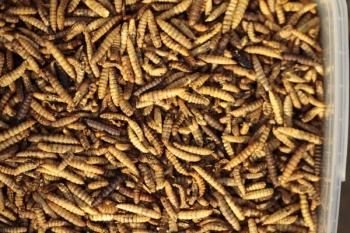
Current concepts for management of chronic renal failure in dogs: nutritional support (Proceedings)
Chronic renal failure (CRF) is the most common form of renal disease in dogs and cats, and it is generally considered a progressive and irreversible disease.
Chronic renal failure (CRF) is the most common form of renal disease in dogs and cats, and it is generally considered a progressive and irreversible disease. It is estimated that 1 in 3 elderly cats and 1 in 5 elderly dogs in the United States have CRF. Despite recent controversy over "optimal" dietary management, dietary therapy continues to be a mainstay in the management of dogs and cats with CRF. Unfortunately, reports emphasizing the failure of protein-restriction to modulate progression of renal failure in dogs (and perhaps cats) has left many veterinarians with the impression that protein restriction, and in some cases any dietary therapy, is no longer recommended for managing patients with CRF.
Dietary Protein Restriction
Most studies evaluating effects of diet in canine CRF have supported the position that protein restriction does not slow progression of CRF. Although clear evidence is lacking at this time that dietary protein restriction alone slows down progression of CRF in dogs, this should not be interpreted to mean that dietary protein restriction has no beneficial effects in dogs with CFR. Dietary protein restriction may still have some extrarenal clinical benefits. The primary rationale at this time for restricting dietary protein intake in dogs with CRF is based on the premise that reducing nonessential dietary protein intake will decrease production of nitrogenous wastes, thereby ameliorating clinical signs of uremia, including anorexia, vomiting, lethargy, and weight loss. It is generally believed that retained protein catabolites contribute significantly to the signs of uremia as well as many of the laboratory abnormalities found in patients with renal failure. Therefore, even if it is eventually proven that dietary protein restriction has no effect on progression of CRF in dogs, few veterinary nephrologists would conclude that there is no benefit of using dietary protein restriction.
1. Clinical Study Comparing the Effects of a Maintenance Diet versus a Renal Failure Diet in Dogs with Spontaneous CRF
A recently published study (Jacob, 2002) evaluated whether dogs with spontaneous CRF benefited from consuming a renal failure diet versus a standard maintenance diet. Thirty-eight dogs with spontaneous CRF were evaluated in this double-blinded, randomized, controlled clinical trial. Both the renal failure diet and the maintenance diet used in this study were complete and balanced, as substantiated by AAFCO feeding trials. The maintenance diet was formulated to mimic 10 popular commercial adult maintenance diets.
Results comparing the effects of the maintenance diet versus the renal failure diet showed that feeding the renal diet had beneficial effects regarding uremic crises and mortality rate in dogs with mild and moderate CRF. In addition, dogs fed the renal failure diet had a slower decline in renal function, compared with dogs fed the maintenance diet. A median of 615 days elapsed before uremic crisis developed in the renal failure diet group. In contrast, a median of only 252 days elapsed before uremic crises developed in the maintenance diet group.
The authors concluded that dietary modifications are beneficial in minimizing extrarenal manifestations of uremia and mortality rate in dogs with mild to moderate spontaneous CRF. Results were also consistent with the hypothesis that the delay in development of uremic crises and associated mortality rate in dogs fed the renal failure diet may have been associated, at least in part, with reduction in rate of progressions of renal failure.
2. Optimal Levels of Dietary Protein Restriction in Dogs with Spontaneous CRF
While numerous studies have been performed to evaluate the effect of protein restriction on progression of induced CRF in dogs, relatively few studies have been performed to establish the clinical efficacy of dietary protein restriction in dogs with spontaneous CRF. For example, although the clinical study by Jacob and colleagues showed beneficial effects from feeding dogs with spontaneous CRF a renal failure diet rather than a maintenance diet, it is unknown if the level of protein in these diets was responsible for some or all of the beneficial effects seen.
Optimum levels of dietary protein requirements for dogs with CRF have not been established. However, when dogs with moderate CRF were fed a diet containing 1.25 gm of cooked egg protein/kg body weight/day for 40 weeks, clinical and laboratory evidence of protein malnutrition developed, characterized by hypoalbuminemia, anemia, weight loss, and reduced body tissue mass. In this same study, dogs fed 3.6 gm of protein/kg body weight/day did not develop clinical or biochemical evidence of protein malnutrition. Results of this study indicate that diets deficient in protein may be deleterious for patients with CRF. However, neither the optimal level of dietary protein for dogs with CRF nor whether various levels of azotemia require different levels of protein restriction is still not known.
Dietary Phosphorus Restriction
Altered calcium and phosphate metabolism and consequent renal secondary hyperparathyroidism result in deposition of calcium and phosphate in the renal parenchyma of animals with CRF. Renal deposition of calcium and phosphate leads to inflammation, scarring, and subsequent loss of nephrons. Dietary phosphate restriction appears to slow progression of CRF and prolong survival in dogs with induced CRF. A study by Finco (Finco, et al, 1992) evaluated the effects of dietary protein and phosphorus on young adult mongrel dogs made azotemic by surgical reduction of renal mass. The investigators concluded that when renal function is reduced to the point where moderate azotemia occurs, dietary restriction of inorganic phosphate is beneficial in dogs. Other results from this study showed that:
- Dog survival was significantly enhanced by dietary phosphorus restriction, but not by dietary protein restriction.
- Phosphorus restriction significantly increased the period of time of stable GFR prior to decline, based on measurements of GFR. However, dietary protein did not have any significant effect on GFR.
The investigators suggest that dietary phosphorus restriction has several extrarenal beneficial effects which result in an increased duration of survival. These studies indicate that phosphorus restriction is indicated once CRF has progressed to the point of azotemia. Potential benefits from phosphorus restriction in dogs prior to the onset of azotemia have not been assessed.
Dietary Lipids
The amount and type of fat in the diet may affect the progression of CRF through several mechanisms. Dogs with CRF may develop glomerular hypertension, and dietary lipids may influence intrarenal pressure through the effects on renal eicosanoid metabolism. For example, eicosanoids produced from omega-6 fatty acids results in increased renal blood flow and increased GFR, which can exacerbate glomerular hypertension further. In addition, metabolism of omega-6 fatty acids produces eicosanoids that are proinflammatory and promote platelet aggregation, whereas eicosanoids produced from omega-3 fatty acids are less inflammatory and do not promote platelet aggregation. Therefore therapies that reduce glomerular hypertension and inflammation may significantly slow the progression of CRF.
In a study by Brown (1998), the effects of three different types of dietary fat on GFR were evaluated in dogs with induced renal failure. Dogs were fed a low-fat diet supplemented with either beef tallow (a source of saturated omega-6 fatty acids), safflower oil (a source of unsaturated omega-6 fatty acids), or menhaden fish oil (a source of unsaturated omega-3 fatty acids) for 20 months. Results showed that dogs fed the menhaden
fish oil-supplemented diet had reduced proteinuria and lower levels of serum creatinine, cholesterol, and triglycerides compared to dogs fed either the safflower oil-or beef tallow-supplemented diets. Dogs fed the menhaden fish oil-supplemented diet also did not exhibit signs of progressive loss of renal function, and in fact, actually had GFR values that indicated a slight increase in renal function. In contrast, dogs fed the safflower oil-or beef tallow-supplemented diets showed progressive loss of renal function throughout the study. The results indicate that omega-3 fatty acids may be renoprotective, whereas, omega-6 fatty acids may contribute to disease progression.
Dietary Fiber
Dietary protein restriction is one method of reducing the amount of nitrogenous end products that must be excreted by the kidneys. A second proposed method for reducing the amount of nitrogenous end products that must be excreted by the kidneys is to alter their route of excretion. For example, feeding fermentable fiber alters the flux of urea and ammonia in the large intestines, resulting in some urea excretion occurring in the large intestines. The mechanism for this effect involves the effects of dietary fiber on bacterial growth in the GI tract. It has been shown that feeding fermentable fiber results in increases in bacterial growth and activity in the large intestine. This is accompanied by increased colonic blood flow, tissue weights, surface area, and nitrogenous excretion. Bacterial growth requires a source of nitrogen, and although dietary protein provides some nitrogen to the bacteria, blood urea is the largest and most available source of nitrogen for bacterial protein synthesis in the large intestines. When blood urea diffuses into the large intestine, it is broken down by bacterial ureases and used for bacterial protein synthesis. These bacterial proteins are excreted in the feces, resulting in a net effect of increased fecal urea excretion, reduced serum urea nitrogen concentration, and reduced requirements for urinary urea excretion.
Preliminary results from studies in dogs suggest that including a blend of fermentable fiber sources in the diet of dogs with CRF is efficacious because it allows higher levels of dietary protein to be fed to uremic dogs, thus providing optimal protein levels without the development of protein deficiency. Cats appear less tolerant of fermentable fiber in the diet. Feeding cats highly fermentable fiber causes significant decreases in protein and lipid digestibility. Therefore, feeding high levels of fermentable fiber to cats with CRF is currently not recommended.
Newsletter
From exam room tips to practice management insights, get trusted veterinary news delivered straight to your inbox—subscribe to dvm360.






